As chum and chinook salmon numbers dwindle in Western Alaska, salmon bycatch in the pollock industry was a main concern addressed by the North Pacific Fishery Management Council, or NPFMC, from June 6 to 14.
In 2021, over 15,000 chinook salmon were caught as bycatch by pollock fishermen, according to a statement from the Bering Sea Fishermen association. In the same year, pollock fishermen caught 550,000 chum bycatch.
With the low runs and river closures happening all over Alaska this summer, this means that precious salmon which could have made it to subsistence fishermen is instead being caught and thrown away.
Social science program director for Kawerak, Julie Raymond-Yakoubian who helped represent Kawerak at the NPFMC meeting, deplores this waste.
“The traditional value of not wasting and also of only taking what you need are points that we are constantly emphasizing when we’re at the North Pacific Council. You know, each tribe has their own traditional values but these two are pretty ubiquitous across Western Alaska. We talk about how those values are not taken into consideration in this federal fisheries management process,” Raymond-Yakoubian said.
Kawerak joined other organizations such as the Association of Village Council Presidents, the Aleut Community of St. Paul Island and the Kuskokwim River Inter-Tribal Fish Commission in writing a petition to the Secretary of Commerce. The Secretary of Commerce has the authority “to issue emergency regulations to ensure that salmon bycatch in the pollock industry is not the final straw for our salmon runs,” according to Raymond-Yakoubian.
Kawerak exhorted the NPFMC and the Secretary to take strong action to reduce salmon bycatch and, in particular, to set a cap on chum bycatch in the pollock fishery.
“Emergency action is necessary to address severe and unforeseen ecological, economic, social and public health concerns affecting Western Alaska and Interior Alaska communities that depend on salmon,” the petition stated.
The goal is one day to reduce salmon bycatch in the pollock industry down to 0%, Raymond-Yakoubian said.
Alaskan subsistence fishers at the NPFMC meeting echoed this request and proposed solutions to the bycatch issue.
Chief Karma Ulvi of the Native Village of Eagle called bycatch a factor we can control.
“I would ask the council to please lower the caps on chinook salmon bycatch, at least to 10,000. Implement a chum salmon bycatch with a 10,000 limit. We are asking for more research on excluder nets and to make mandatory for all ships. My last request would be to include tribes in a working group … to collaborate to reduce bycatch,” Ulvi said.
Vivian Korthuis Chief Executive officer for the Association of Village Council presidents and Emmonak resident asked for an immediate reduction on bycatch rather than more studying before the council takes direct action.
“We cannot continue to wait for runs, reconstruction, and bycatch impact analysis to be completed before this body takes action to reduce the thousands of salmon taken as bycatch each season,” Korthuis said.
She stressed the urgency of the issue and how the crash in salmon stock is happening now. “At this point there should be alarm bells going off all over, not only in our community, but all over the state and federal government agencies,” Korthuis said.
In her testimony, Korthuis mentioned that things such as seashare and fishery disaster programs are necessary but are not long term solutions.
“Our tribe wants solutions, not temporary measures. We don’t want to have to tell our grandchildren and great grandchildren ‘I remember when there used to be salmon here in this river,'” Korthuis said.
Ultimately, the council passed motions to write a discussion paper about chum bycatch and to develop a working group to look at bycatch issues. Raymond-Yakoubian calls the lack of stronger action, such as a cap on chum bycatch, disappointing.
“Unfortunately, they didn’t take any real concrete action that is going to help stem the salmon crisis that our communities in all of Western Alaska, and up into our rivers in the Interior, the Yukon, the Kuskokwim, that everyone is suffering through right now and has been for some time,” Raymond-Yakoubian said.
Kawerak encourages anyone who has been affected by the salmon shortages to speak out to the NPFMC about their experiences. Kawerak is offering training sessions for anyone who wants help preparing testimony.
The North Pacific Fishery Management Council will meet again in October and in December after the 2022 summer salmon fishing season has concluded.
Image at top: Dead pink salmon floating in the Shaktoolik River. Photo provided by Sophia Katchatag, Community Coordinator for the Native Village of Shaktoolik (2019).




